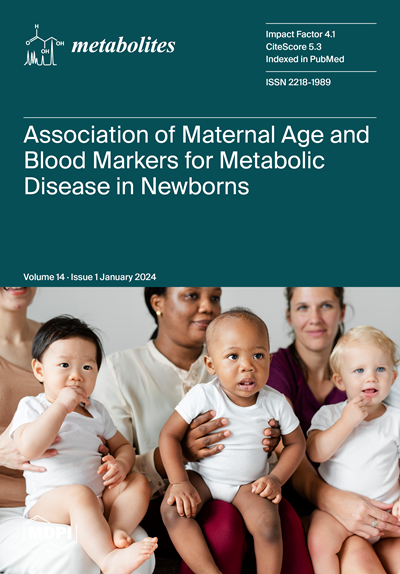鉴定幼年特发性关节炎的血浆代谢组生物标记物
IF 3.4
3区 生物学
Q2 BIOCHEMISTRY & MOLECULAR BIOLOGY
引用次数: 0
摘要
疾病和治疗生物标志物的鉴定仍然是早期诊断和有效治疗幼年特发性关节炎(JIA)的重大挑战。本研究通过血浆代谢组学分析来确定与 JIA 相关的疾病相关代谢生物标志物。在发现队列(60 名 JIA 患者,60 名非 JIA 患者)和复制队列(49 名 JIA 患者,38 名非 JIA 患者)中,对未经治疗的 JIA 患者和非 JIA 参考患者的血浆样本进行了全球代谢组学分析。单变量分析确定了重要的代谢物(q 值≤ 0.05),随后使用 ChemRICH 进行了富集分析,并使用 MetaMapp 和 Cytoscape 绘制了代谢网络图。根据曲线下面积(AUC)值,接收者操作特征(ROC)分析确定了最具鉴别力的生物标记物。共测定了 800 多种代谢物,其中包括 714 种已知化合物和 155 种未知化合物。在发现队列中,与参照人群相比,JIA 患者体内有 587 种代谢物发生了显著变化(q < 0.05)。在复制队列中,288个代谢物发生了明显变化,其中78个重叠的代谢物在两个队列中表现出相同的方向性变化。JIA 与血浆中鞘氨醇代谢物和脂肪酸乙醇酰胺水平的明显升高以及肌氨酸、亚氨基二乙酸盐和未知代谢物 X-12462 水平的降低有关。化学富集分析确定了以萘普生及其代谢物形式存在的环链烷烃、不饱和溶血磷脂、饱和磷脂酰胆碱、鞘磷脂、乙醇胺和饱和神经酰胺是最具鉴别力的生化组群。根据 AUC > 0.90,ROC 曲线分析确定了 11 种具有高度鉴别性的代谢物,其中最具鉴别性的代谢物是鞘氨醇-1-磷酸(AUC = 0.98)。这项研究通过发现队列和复制队列确定了JIA的特定代谢变化,特别是鞘磷脂代谢的变化。血浆代谢组学分析有望精确定位JIA特异性生物标志物,并将它们与健康对照组和克罗恩病的生物标志物区分开来,从而改善诊断和治疗。本文章由计算机程序翻译,如有差异,请以英文原文为准。
Identification of Plasma Metabolomic Biomarkers of Juvenile Idiopathic Arthritis
Identification of disease and therapeutic biomarkers remains a significant challenge in the early diagnosis and effective treatment of juvenile idiopathic arthritis (JIA). In this study, plasma metabolomic profiling was conducted to identify disease-related metabolic biomarkers associated with JIA. Plasma samples from treatment-naïve JIA patients and non-JIA reference patients underwent global metabolomic profiling across discovery (60 JIA, 60 non-JIA) and replication (49 JIA, 38 non-JIA) cohorts. Univariate analysis identified significant metabolites (q-value ≤ 0.05), followed by enrichment analysis using ChemRICH and metabolic network mapping with MetaMapp and Cytoscape. Receiver operating characteristic (ROC) analysis determined the top discriminating biomarkers based on area under the curve (AUC) values. A total of over 800 metabolites were measured, consisting of 714 known and 155 unknown compounds. In the discovery cohort, 587 metabolites were significantly altered in JIA patients compared with the reference population (q < 0.05). In the replication cohort, 288 metabolites were significantly altered, with 78 overlapping metabolites demonstrating the same directional change in both cohorts. JIA was associated with a notable increase in plasma levels of sphingosine metabolites and fatty acid ethanolamides and decreased plasma levels of sarcosine, iminodiacetate, and the unknown metabolite X-12462. Chemical enrichment analysis identified cycloparaffins in the form of naproxen and its metabolites, unsaturated lysophospholipids, saturated phosphatidylcholines, sphingomyelins, ethanolamines, and saturated ceramides as the top discriminating biochemical clusters. ROC curve analysis identified 11 metabolites classified as highly discriminatory based on an AUC > 0.90, with the top discriminating metabolite being sphinganine-1-phosphate (AUC = 0.98). This study identifies specific metabolic changes in JIA, particularly within sphingosine metabolism, through both discovery and replication cohorts. Plasma metabolomic profiling shows promise in pinpointing JIA-specific biomarkers, differentiating them from those in healthy controls and Crohn’s disease, which may improve diagnosis and treatment.
求助全文
通过发布文献求助,成功后即可免费获取论文全文。
去求助
来源期刊

Metabolites
Biochemistry, Genetics and Molecular Biology-Molecular Biology
CiteScore
5.70
自引率
7.30%
发文量
1070
审稿时长
17.17 days
期刊介绍:
Metabolites (ISSN 2218-1989) is an international, peer-reviewed open access journal of metabolism and metabolomics. Metabolites publishes original research articles and review articles in all molecular aspects of metabolism relevant to the fields of metabolomics, metabolic biochemistry, computational and systems biology, biotechnology and medicine, with a particular focus on the biological roles of metabolites and small molecule biomarkers. Metabolites encourages scientists to publish their experimental and theoretical results in as much detail as possible. Therefore, there is no restriction on article length. Sufficient experimental details must be provided to enable the results to be accurately reproduced. Electronic material representing additional figures, materials and methods explanation, or supporting results and evidence can be submitted with the main manuscript as supplementary material.
 求助内容:
求助内容: 应助结果提醒方式:
应助结果提醒方式:


